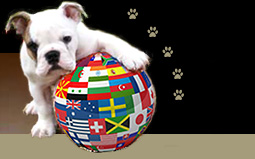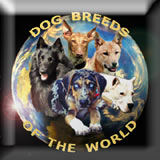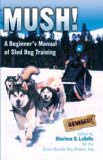.
.
.
.
Origin
The Malamute is a descendant of the northen sled dogs kept by the Mahlemut Inuits of the Baldwin Peninsula in in the northwestern region of Alaska. The Mahlemut people were nomadic people who lived in harsh and extreme conditions. Their dogs had a prominent role in their lives, working, hunting, and living alongside them. Their reputation of great strength, endurance, courage, and loyalty made them great family pets and fantastic freighting dogs. They were capable of pulling a tremendous amount of weight over long distances at a steady pace, even in extreme conditions. Malamutes thrive on work and nothing bores them more than being inactive.
Alaskan Malamutes have contributed actively to a great number of endeavors in the history of humankind. In Alaska the dogs were preferred over the reindeer for transporting goods. Dogs could step over the ice without breaking their legs in cracks, unlike the reindeer. They could carry their own food and wouldn't wander off at night in search for food, but would stay close to the camp.
As early as 1873, the Royal Canadian Mounted Police were bringing government to northern frontiers with dog-team patrols. During the Klondike Gold Rush in 1896, dogs transported prospectors and settlers, as well as freight. They were often the only reliable means of transportation for the mail service in Alaska and remote regions of Canada.
They were so important that a federal law required all other sled dog teams to yield right-of-way to any mail-carrying dogs encountered.
The peak of mail service dog teams was from around 1910 into the late 1930's. As the postal service began replacing dog teams with airlines, sled dog carriers were phased out. In 1963, the last U.S. Postal Service mail driver retired with his dog team.
Dogs continued performing these traditional tasks for decades, including transporting serum to Nome during the diphtheria epidemic of 1925. In January of that year, a case of diphtheria was discovered in Nome, Alaska, and the supply of antitoxin in that city was inadequate to stave off an epidemic. A relay of 22 native and mail teams forged through the rough interior of Alaska and across the Bering Sea ice to bring the serum to a grateful citizenry. In New York City's Central Park stands a statue of Balto, who led one of the relay teams, commemorating the Nome Serum Run. The inscription reads: "Dedicated to the indomitable Spirit of the sled dogs that relayed the antitoxin 600 miles over rough ice, treacherous waters; through Arctic blizzards from Nenana to the relief of stricken Nome in the winter of1925." Endurance. Fidelity. Intelligence.
Alaskan Malamutes also served as military dogs during WII, pulling sleds or assisting in search and rescue operations. Alaskan Malamutes have also played a key role in countless expeditions.
In 2009, the House voted 31-6 in favor of HB14, which would formally designate the malamute as Alaska's state dog. The governor finally signed the House Bill 14 into law in May 2010, making the Alaskan Malamute the official state dog.
Character and Temperament
Alaskan Malamutes are overly friendly, extremely sweet and, like all sled dogs, pack oriented.
They are very independently minded dogs and can therefore prove to be a training challenge. When properly trained they make an excellent companion for families with children.























